|
Related FAQs: Bristle/Fireworms 1, Bristle/Fireworms 2, Bristle/Fireworms 3, Bristle/Fireworms 4, Polychaete Identification, Polychaete ID 2, Polychaete ID 3, Polychaete ID 4, Polychaete ID 5,
Bristleworm ID 6, Bristleworm ID 7, Bristleworm ID 8,
Bristleworm ID 9,
Bristleworm ID 10,
Bristleworm ID 11,
Polychaete Behavior, Polychaete Compatibility, Polychaete Compatibility 2, Polychaete System, Polychaete Selection, Polychaete Feeding, Polychaete Disease, Polychaete Reproduction,
Featherdusters, Featherdusters 2, Tubeworms 3, Tubeworm ID, Tubeworm Behavior, Tubeworm Compatibility, Tubeworm Selection, Tubeworm System, Tubeworm Feeding, Tubeworm Disease, Tubeworm Reproduction, Worms in General,
Related Articles: Featherduster Worms, Worm Diversity,
/The Conscientious Marine
Aquarist
Bristleworms, Fireworms
& More: Errantiate Polychaete Worm
Diversity
To: Featherduster,
Sedentariate Polychaete Worms
|
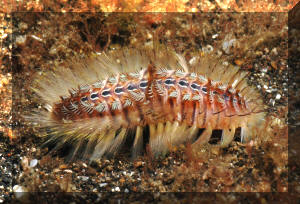
|
|
By Bob Fenner
|
Fire! |
By some estimates there are more species of
"worms" than insects! Most of the large groups, the phyla of
Roundworms (Nematoda), Flatworms (Platyhelminthes) and Segmented Worms
(Annelida) are barely known to most of us. The very common and
important other "wormy" groups are virtually unknown. We use
these organisms consciously as food, to help keep our substrates from
compacting and channeling, as filter-feeding "cleaners" in
marine reef systems and dook it out with them as disease carrying and
causing parasites and competitors.
Why the lack of respect? What is this, another example of
species-centricity? Worms are everywhere; in your hair, in the air, in
the deepest seas, warmest waters, driest deserts... Doing everything:
parasitic, free-living, filter-feeding planktivores, detritivores,
ferocious predators, sneaky vacuum cleaners...
Yes, worms are wormy; often slimy, reclusive,
mysteriously appearing and disappearing. But they were here first! All
major and minor worm groups were on the planet in full force before the
Cambrian. They are still critically functioning as aerators,
facilitators of decomposition and general energy transfer/recycling and
as store houses of food energy and webbing themselves. Let's use
this brief article to discuss one phylum of worms often encountered on
purpose and accident by marine hobbyists, Polychaete Annelidans:
Classification:
In the world of zoological taxonomy feather dusters,
duster-cluster, bristle, fire, fan, tube...worms are grouped/placed in
the Annelida, generally known as the "segmented worms", in
reference to their metamerism or segmented appearance.
This segmentation allows for different types of
locomotion, several environments. External and internal segmentation is
obvious in the body, parapodia (lateral processes), nervous, muscular,
excretory and circulatory systems arranged in repetitive placement.
There are three living Classes:
1) Oligochaeta, meaning
"few bristles", the ubiquitous "earthworms" that
indeed do have small body bristles.
2) Hirudinea, the leeches. All
basically parasitic.
The above two are mostly freshwater and terrestrial and
differ generally in basic ways in terms of internal anatomy, having
permanent gonads...unlike the
3) Polychaeta ("many
bristles"), some are downright prickly, are mainly marine. They
have a head end (prostomium) with a typical sensory array of tentacles,
papillae, eyes... and a posterior segment (pygidium). New sections are
added right before the pygidium. What else? longitudinal muscled bands
effect motion through contracting against a fluid filled body cavity
(coelom). The digestive tract is a more or less straight tube running
from the anterior mouth to the posterior anus. Most do have a
"closed" circulatory system, blood and a "heart",
an anterior dorsal ganglionic mass (brain), lateral nerves in each
segment, blah, blah, blah. And they're neat! Some are big (larger
than your hand, longer than your fish. And here, fellow pet-fish
commandos, I must confess to a certain period of intransigency when
even I lived on the public largesse. For a couple of years in grad.
school I did "environmental" work sorting and identifying
benthic marine invertebrates, principally polychaete worms. My dear
cubicle mate actually had a beautiful graphic of a Glycerid polychaete
worm with double everted jaws (shades of Aliens I and II & III),
multiple eyes and specialized parapodia with a blasphemous label
"God is a Polychaete!
There are so many species of polychaetes occurring most
everywhere in marine environments with known life "habits"
that much can be discerned by collecting, i.d.ing, counting 'em up
and measuring now and later to determine "impact" of human or
other activity.
So yes, money can be made with
life science degrees! My roomie used to do Errantiates and I'd get
stuck with the Sedentariates. Hey, what are they!? Glad you asked; back
to the story at hand:
Polychaetous Annelids are sub-divided into two
sub-classes:
| A) Errantia: Characteristics include numerous, similar
segments, well-developed lateral processes (parapodia, acicula,
setae). Have definitive "heads" with a pharynx with jaws
or teeth. Include swimming (six pelagic families!), crawling,
burrowing and tube-dwelling members. And, ahem, the group in
question: Hermodice canunculata. |
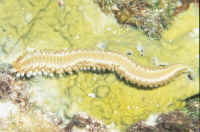
|
|
B) Sedentaria: Polychaetes that commonly
display a high degree of segmental differentiation; parapodia
reduced, without specialized acicula or setae, prostomium (head)
without sensory structures but with tentacles and palps, other
feeding structures. No teeth or jaws present! Several families
including the two commonly included as the trade and hobbies fan
and feather duster worms, the i. Sabellidae with non-calcareous tubes
(Anamobaea onstedii at right, Cozumel pic).
ii. Serpulidae
with calcareous tubes (Spirobranchus gigantea at
right)
|
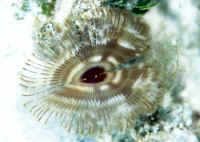 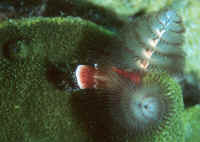
|
Errantiate Polychaetes (Bristle, Fire...) Worms... On
Parade!
| The vast majority of worms are good indeed... for keeping your
substrates open, free of accumulating mulm, providing food for
macro-eaters as well as filter feeders (their sex products)... Here
is a side view through a healthy substrate. |
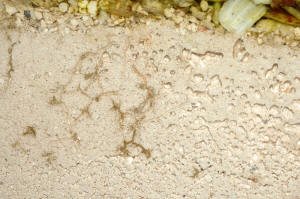
|
| Amphinomid... Fireworm of the family
Amphinomidae. If it's not visually obvious where these worms
get their common name, you'll understand if you handle them!
The bristles attached to their noto- and neuropodia are sharp and
hurt like no tomorrow to get stuck by. Ouch! This one out and about
at night in N. Sulawesi. |
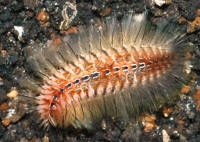
|
Bigger PIX:
The images in this table are linked
to large (desktop size) copies. Click on "framed" images
to go to the larger size. |

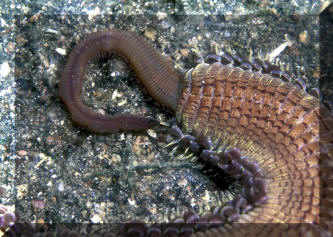 |
| Chloeia fusca McIntosh 1885. Family
Amphinomidae). Indo-West Pacific; East Africa to Indonesia, Japan.
On sandy, muddy bottoms, actively seeking prey. Positively
phototropic. Note two dark dorsal bands. N. Sulawesi
pic. |
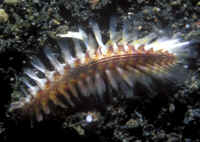
|
| Hermodice canunculata, a larger species of
"Bristleworm". Large pleated structures (caruncle) on all
segments denote this too common, out and about species in the
tropical West Atlantic. Family Amphinomidae. Four to six inches
total length. Often found feeding on gorgonians, anemones, hard
corals. Close-up to show you part of the "fire", the
sharp bristles that make up the podia on each segment of the body.
Bahamas, Cancun and Cozumel images by day and Bonaire at
night.. |
Family Eunicidae: Bobbit Worms!
|
Howsit? Yes, on Xmas, am going over pix...
12/25/12
Lynn... do you have any idea what this might be? Looks so much like a
trap door spider opening... underwater! In Cozumel this last week. B
<Wow, I know I've seen one of these before, but can't remember what made
it. I'll get back to you as soon as I figure it out. Take
care, Lynn>
Oh, thank you... have a couple more pix of this/it... but all about the
same. Cheers! B
|
.JPG) |
Re: Howsit? Yes, on Xmas, am going over pix...
12/26/12
Hi Bob,
I think the webbing is part of a eunicid's lair. When I see
webs, the first thing I think of is a vermetid but in this case, the entire
structure, combined with the associated threads, looks too intentionally
shaped and anchored - like that of a funnel-web/trapdoor spider. A
vermetid’s would have been a lot messier and more random.
I’ve heard about these webs, specifically from eunicids, but have never seen
one in person. It’s entirely possible that other Polychaetes
build/live in such, but I just don’t know of them. I looked through
all my resources, and on the web, but with no luck. I did, however,
manage to find a couple of photos showing eunicid webbing, but one is small
and hard to see detail and the other is detailed but shows a much smaller
web example (in the sand, not anchored to nearby rocks).
Small photo, 2nd one down, showing webbing across the back of the tank:
http://www.dailykos.com/story/2008/12/11/672001/-Marine-Life-Series-A-Worm-Named-Eunice
<Ah, I read the description as "a spider web" there>
Webbed lining w/some around perimeter:
http://www.scuba-equipment-usa.com/marine/MAY04/Sand_Worm(Eunice_sp)4.html
<Ah yes; we have a winner!>
Wish I could give you a concrete answer but unfortunately, a somewhat
educated guess is all I can offer!
Take care,
-Lynn
<Thank you for yet another mysterious pic/organism solved. BobF>
Re: Howsit? Yes, on Xmas, am going over pix...
12/26/12
You're very welcome, Bob - it was a pleasure as always!
-Lynn |
Family Terebellidae: Spaghetti Worms. Surface deposit
feeders
| Loimia medusa (Savigny 1820), the Medusa or
Spaghetti Worm. Cosmopolitan; all tropical seas. Found between
rocks in silt to sandy substrates. Tube-dwelling (family
Terebellidae) worm that is most often recognized by its extended
feeding tentacles. Hawai'i image. |
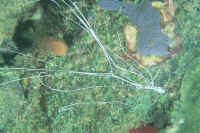
|
| Eupolymnia crassicornis
(Schmarda,
1861), Spaghetti Worm. |
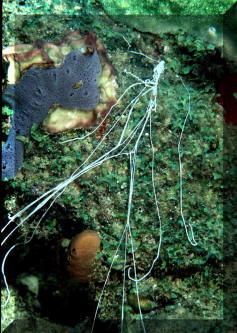
|
Bigger PIX:
The images in this table are linked
to large (desktop size) copies. Click on "framed" images
to go to the larger size. |
|
%20MD.JPG)
|
| Here a group of Spaghetti Worms living in close proximity in Costa Rica
(Pacific side), 2011. |
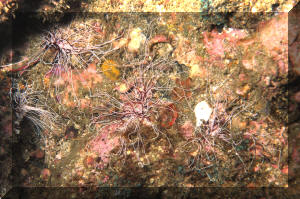
|
Bigger PIX:
The images in this table are linked to large
(desktop size) copies. Click on "framed" images to go to
the larger size. |
|
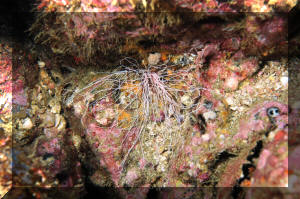
|
To: Featherduster,
Sedentariate Polychaete Worms
|
|

